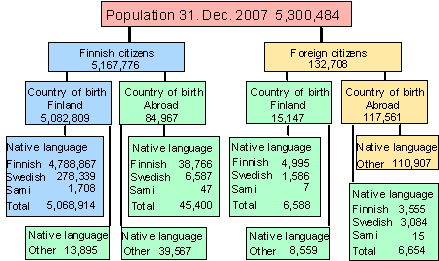Published: 28 March 2008
The population of Finland in 2007
On 31 December 2007 the total population of Finland was 5,300,484 of which 2,596,787 are men and 2,703,697 women. In the course of 2007 Finland’s population grew by 23,529 persons and the increase in population was the biggest since 1992. For the first time during Finland’s independence Finland’s migration gain from abroad contributed more to the increase in population than natural growth.
Of the population, 16.9 per cent are children aged 0 to 14 and 16.5 per cent are over 65 years of age. The demographic dependency ratio, that is the number of under 15 and over 65-year-olds per 100 working age persons was highest in the region of Etelä-Savo (57.2) and South Ostrobothnia (57.1). The demographic dependency ratio was lowest in the region of Uusimaa (42.8) and Pirkanmaa (49.7).
The largest age group in Finland’s population is made up of persons born in 1948. At the end of 2007 they numbered 84,016. Persons over 100 years of age numbered 458, of whom 60 are men and 398 women. Only one person in the population was born in the 19th century.
During 2007 the population grew in 12 and shrunk in 8 regions. In absolute numbers the population grew most in the regions of Uusimaa, by 15,364 persons, and Pirkanmaa, by 4,450 persons. In relative numbers the population grew most in the regions of Uusimaa, by 1.1 per cent, and Itä-Uusimaa, by 1.0 per cent. In absolute numbers the population shrunk most in the regions of Etelä-Savo, by 1,630 persons, and Satakunta, by 929 persons. In relative numbers the population shrunk most in the regions of Etelä-Savo, by 1.0 per cent and Satakunta, by 0.7 per cent.
After the municipal consolidation of Joutsa and Leivonmäki in early 2008, Finland now has 415 municipalities. During 2007 the population grew in 167 and shrunk in 242 municipalities. Helsinki had the biggest absolute increase in population (4,010 persons), followed by Espoo (3,028 persons) and Vantaa (2,811 persons). The municipalities of Lemu and Liminka had the biggest relative increases, at 6.4 and 5.5 per cent, respectively. Kuusankoski had the biggest absolute decrease in population (347 persons), followed by Savonlinna (343 persons) and Lieksa (324 persons). The municipalities of Kökar and Lestijärvi had the biggest relative decreases, at 4.7 and 4.0 per cent, respectively.
Population by age in 1980 - 2007
| Year | Population | Aged 0 - 14 | Aged 15 - 64 | Aged 65 - | 0 - 14 % | 15 - 64 % | 65 - % |
| 1980 | 4787778 | 965209 | 3245187 | 577382 | 20.2 | 67.8 | 12.1 |
| 1985 | 4910664 | 951532 | 3341398 | 617734 | 19.4 | 68.0 | 12.6 |
| 1990 | 4998478 | 964203 | 3361310 | 672965 | 19.3 | 67.2 | 13.5 |
| 1995 | 5116826 | 971770 | 3412639 | 732417 | 19.0 | 66.7 | 14.3 |
| 2000 | 5181115 | 936333 | 3467584 | 777198 | 18.1 | 66.9 | 15.0 |
| 2005 | 5255580 | 906904 | 3507511 | 841165 | 17.3 | 66.7 | 16.0 |
| 2006 | 5276955 | 901181 | 3507057 | 868717 | 17.1 | 66.5 | 16.5 |
| 2007 | 5300484 | 894590 | 3530663 | 875231 | 16.9 | 66.6 | 16.5 |
At the end of 2007 Finland was the country of permanent residence of 5,167,776 Finnish citizens, i.e. 97.5 per cent of the population, and 132,708 foreign citizens, i.e. 2.5 per cent of the population. During 2007 the number of foreign citizens grew by 10,969 persons. The largest groups of foreign citizens were from Russia (26,211 persons), Estonia (20,006 persons), Sweden (8,349 persons) and Somalia (4,852 persons). The number of persons who were born abroad but live in Finland was 202,528.
Of the population of Finland 4,836,183 persons (91.2 per cent) had Finnish as native language, 289,596 persons (5.5 per cent) Swedish and 1,777 persons (0.03 per cent) Sami.
Persons with a native language other than Finnish, Swedish or Sami numbered 172,928, or 3.3 per cent of the population. The largest foreign-language groups spoke Russian (45,224 persons), Estonian (19,812 persons), English (10,589 persons), Somali (9,810 persons) and Arabic (8,119 persons).
Country of birth, citizenship and mother tongue of the population 31.12.2007

Source: Population and Cause of Death Statistics. Statistics Finland
Inquiries: Markus Rapo (09) 1734 3238
Director in charge: Jari Tarkoma
Publication in pdf-format (324.2 kB)
- Tables
-
Tables in databases
Pick the data you need into tables, view the data as graphs, or download the data for your use.
Appendix tables
- Regional adjustments 1.1.2008 (28.3.2008)
- Population by province 31.12.2007 and increase of population (28.3.2008)
- Population by region 31.12.2007 and increase of population (28.3.2008)
- Figures
-
- Population in Finland 1750 - 2007 (28.3.2008)
- Population by age 31.12.2007 (28.3.2008)
- Population by age, marital status and sex 31.12.2007 (28.3.2008)
- The largest foreign-language groups 1997 and 2007 (28.3.2008)
- Foreign citizens by sex 1980 - 2007 (28.3.2008)
- Quality descriptions
-
- Quality description (28.3.2008)
Updated 28.3.2008
Official Statistics of Finland (OSF):
Population structure [e-publication].
ISSN=1797-5395. 2007. Helsinki: Statistics Finland [referred: 17.12.2025].
Access method: http://stat.fi/til/vaerak/2007/vaerak_2007_2008-03-28_tie_001_en.html

